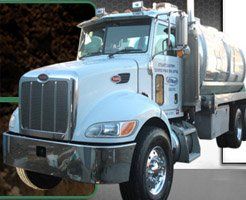Procedures
The most common domestic wastewater treatment system used in rural areas is the septic tank-soil absorption system. The septic tank removes settled and floatable solids from the wastewater. The soil absorption field then filters and treats the clarified septic tank effluent and distributes it through the soil. Removing the solids from the wastewater protects the soil absorption system from clogging and failure. In addition to removing solids, the septic tank also promotes biological digestion of a portion of the solids and stores the remaining undigested portion.
The first stage of the treatment system, the septic tank, removes solids by holding wastewater in the tank. This allows the heavier solids to settle as sludge and the lighter particles to form scum at the top. Up to 50 percent of the solids retained in the tank decompose; the remainder accumulates in the tank. Biological and chemical additives are not needed to aid or accelerate decomposition.

As the system is used, sludge continues to accumulate in the bottom of the septic tank. Properly designed tanks have enough space for up to three years safe accumulation of sludge. When the sludge level increases beyond this point, sewage has less time to settle before leaving the tank and more solids escape into the absorption area. If too much sludge accumulates, no settling occurs before the sewage flows to the soil absorption field. Infiltration of sludge into the soil absorption field can cause system failure. To prevent this, the tank must be pumped periodically. The material pumped is known as septage. However, don't need to look at it to understand the text below.
The frequency of pumping depends on several factors:
1. Capacity of the septic tank.
2. Volume of wastewater (related to size of household).
3. Amount of solids in wastewater (e.g. garbage disposals produce more solids)
Table 1 lists estimated pumping frequency according to septic tank capacity and household size. The frequencies were calculated to provide a minimum of 24 hours of wastewater retention assuming 50 percent digestion of the retained solids.
Table 1 Estimated septic tank pumping frequencies in years
(For year-round residences)
Years between Pumping
Household size (number of people)
Tank Size
(Gal) 1 2 3 4 5 6 7 8 9 10
500* 5.8 2.6 1.5 1.0 0.7 0.4 0.3 0.2 0.1 -
750* 9.1 4.2 2.6 1.8 1.3 1.0 0.7 0.6 0.4 0.3
900 11.0 5.2 3.3 2.3 1.7 1.3 1.0 0.8 0.7 0.5
1000 12.4 5.9 3.7 2.6 2.0 1.5 1.2 1.0 0.8 0.7
(Gal) 1 2 3 4 5 6 7 8 9 10
500* 5.8 2.6 1.5 1.0 0.7 0.4 0.3 0.2 0.1 -
750* 9.1 4.2 2.6 1.8 1.3 1.0 0.7 0.6 0.4 0.3
900 11.0 5.2 3.3 2.3 1.7 1.3 1.0 0.8 0.7 0.5
1000 12.4 5.9 3.7 2.6 2.0 1.5 1.2 1.0 0.8 0.7
1250 15.6 7.5 4.8 3.4 2.6 2.0 1.7 1.4 1.2 1.0
1500 18.9 9.1 5.9 4.2 3.3 2.6 2.1 1.8 1.5 1.3
1750 22.1 10.7 6.9 5.0 3.9 3.1 2.6 2.2 1.9 1.6
2000 25.4 12.4 8.0 5.9 4.5 3.7 3.1 2.6 2.2 2.0
2250 28.6 1 4.0 9.1 6.7 5.2 4.2 3.5 3.0 2.6 2.3
2500 30.9 15.6 10.2 7.5 5.9 4.8 4.0 3.5 3.0 2.6
Note: More frequent pumping is needed if a garbage disposal is used. Generally, the indicated frequency will vary with the volume of solids (+20% for high volume, -20% for low volume).
A 900-gallon septic tank is the minimum size that must be used for a home with three bedrooms or less. If six people reside in a three-bedroom house, the tank should be pumped every 1.3 years. If the same system serves a family of two, the tank would be ready for pumping every 5.2 years. Systems installed before the current rules and regulations were implemented may need to be pumped more often, perhaps every year or less.
As indicated in the footnote to Table 1, garbage disposers will increase the frequency of pumping. For example, if this same three-bedroom house with six residents had a garbage disposal and was generally producing a higher volume of wastewater, the pumping frequency would be calculated as follows:
1.3 years - [(0.2) x 1.3 years] = 1.0 year
If you have just moved into a home, you may not know the size of the tank. In this case, you should have the tank pumped and inspected. The company pumping the tank will tell you its size, age, and condition.
Septic tanks will not fail immediately if they are not pumped. However, an un-maintained septic tank is no longer protecting the soil absorption field from solids. Continued neglect may result in system failure and even replacement of the soil absorption field. In some cases, site limitations may make replacement of the absorption field impossible. If system replacement is the only option, contact your local Sewage Enforcement Officer (SEO) or municipal sanitarian or health department since a permit for the new system will be required.
More explanation: In order for a tank to function properly, adequate liquid volume must be maintained to allow for sufficient "settling time" which permits solids to either settle out as sludge or join the floating-scum layer at the top of the tank. Baffles in the tank prevent the floating scum from leaving the tank, an event that would lead to rapid failure of the absorption system. When pumping is too infrequent, even if the tank is not totally clogged with solids, the reduced liquid volume in the tank cuts settlement time and forces small floating solids out to the absorption system, shortening its life.
Cleaning Septic Tanks
Septic tank pump and haul contractors can clean your tank. It is a good idea to supervise cleaning to assure that it is done properly. To extract all the material from the tank, the scum layer must be broken up and the sludge layer mixed with the liquid portion of the tank. This is usually done by alternately pumping liquid from the tank and re-injecting it into the bottom of the tank. The septic tank should be pumped through the large central manhole, not the baffle inspection ports. Pumping a tank through the baffle inspection ports can damage the baffles, resulting in a destroyed leach field. Before closing the tank, check the condition of the baffles. If they are missing or deteriorated, replace them with appropriate sanitary tee baffles. It should never be necessary to enter a septic tank. Any work to replace the baffles or repair the tank should be done from the outside. Decomposing wastes in the septic tank produce toxic gases, which can kill a human in a matter of minutes. When working on a tank be sure the area is well ventilated and that someone is standing nearby. Never go into a septic tank to retrieve someone who has fallen in and was overcome by toxic gases without a self-contained breathing apparatus (SCBA). If a SCBA is not available, call for emergency services and put a fan at the top of the tank to blow in fresh air. To facilitate future cleaning and inspection, install risers from the central manhole and inspection ports to the surface before buying the tank. Also, mark the location of the tank, so it can be easily identified.
Summary
The septic tank is only one part of an on-site wastewater system. It is designed to remove solids prior to the effluent entering the soil absorption field, provide for the digestion of a portion of those solids, and store the remaining solids. Biological and chemical additives are not needed to aid or accelerate decomposition. Garbage grinders impose an additional solids load on the system. Solids must be removed periodically to prevent them from entering the soil absorption field. For a properly designed septic system, the tank should be inspected and pumped every 1 to 3 years.

Towns Serviced:
Andover, Bolton, Chester, Cobalt, Colchester, Columbia, Coventry, Cromwell, Deep River, Durham, East Haddam, East Hampton, Glastonbury, Haddam, Haddam Neck, Hebron, Higganum, Killingworth, Lebanon, Manchester, Mansfield, Marlborough, Middle Haddam, Middlefield, Middletown, Moodus, Portland, Salem, Tolland, & Windham
YP Reviews
Be the first to review us
Your feedback is important!
